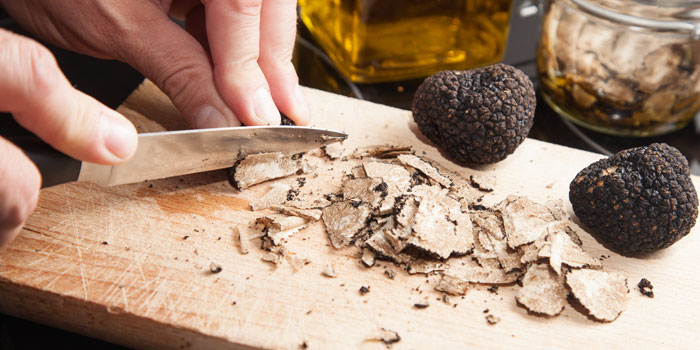
Pronounce it: truff-ill
The black Perigord truffle isn’t the only truffle.
Truffles lauded as Black Diamonds and as having the most heavenly of scents and tastes refer only to a single variety, the true black truffle tuber melanasporum; this variety is widely known as the Perigord truffle because this area of south-west France is considered to produce the best.
Once available to harvest by the kilo and thus used with the same liberality, the Perigord truffle is now considerably less common. While making it thus even more prized, the rarity and appeal also means that minor varieties can be sold to the uninitiated without in anyway explaining that (a) the flavour of these is considerably less anyway or (b) that it has been further lessened by cooking and then might have been enhanced with artificial flavours such as onion or garlic.
If you are not buying fresh truffles, read the label very carefully. Dried porcini mushrooms are invariably a more rewarding choice.
Availability
Black truffles
The Perigord truffle matures in winter and although available pre-Christmas is actually riper and more fully flavoured in the New Year. It grows in far more areas than around Perigord in France but those from there are acknowledged to have a specially aromatic flavour.
Italy has a choice of black truffles worth investigating; the nero liscio sometimes known as a Norcia truffle, is seasonal in August and September. This is followed by the brumale from November to March and both are almost as powerful as the melanosporum. The rarer muscato in February and March has an intense musky nose clearly related to that of the muscat grape and its wine.
White truffles
Powerful, pungent and profoundly sensual, the uber-expensive white truffle alba magnatum cannot be sold before September. Sold as the Piedmont or Alba truffle, it’s in season for just a few months and one of the world’s most expensive foods. The smaller alba pico ripens between February and April and is only slightly less intense in aroma and taste.
Summer truffle
Tuber aestivum has a light flavour, more like that of mushroom even when fresh, and thus it is more a curiosity than a culinary destination. Once cooked and bottled it has almost no flavour of its own, hence the above warning of additives. Widely sold commercially in many guises simply as ‘truffle’, which allows the innocent to believe they’re buying the famed Perigord tuber; somewhere small type will reveal that the content is the summer truffle and thus a paler version.
Other truffles…
There are dozens of other varieties of truffle native to all manner of locations, including the North African desert, but most have little or no flavour. All round the world truffle farms now produce the famed Perigord or melanosporum truffle with great success but also produce the less worthwhile summer or aestivum, something to be admired as long as they market them fresh, but they rarely do.
Truffle farms are producing in Britain now and imported fresh truffles are available in places like London’s Borough Market.
Store it
Fresh truffles are best eaten within a week or so. Store wrapped lightly in cloth or brown paper in an airtight container, ideally refrigerated.
Tightly wrapped truffles can be frozen.
Cook it
Once you have rid the wrinkled skin of earth by dusting with a soft brush, black/brown truffles should be sliced very thinly (there’s a dedicated truffle slicer) and then eaten raw or only lightly cooked for maximum return and headiness; hence why canned and bottled truffles can never perform with more than an echo of their former glory. Avoid cooking with canned or bottled truffles, for this will further reduce their remaining flavour. A hint of scent is the best you can hope for, even when merely sliced and warmed by the heat of scrambled eggs.
White truffles must never be cooked but slicing them directly onto warm or hot food enhances their penetrating scent even more; they go specially well atop anything creamy or eggy, on risottos and rice dishes or, wickedly, onto a warm, buttery brioche.
However, before you eat a fresh melansporum, liscio, brumale, moscato or white truffle, first store it for some days in a sealed container of rice or in a covered bowl of eggs and the perfume will penetrate these. Scrambling such eggs is about the most rewarding thing to do in a kitchen, particularly if you’re the only one eating.
Recipes from old cookbooks best show how to get the most out of truffles but sadly most of them require handfuls of fresh truffles and those days are over; a few slices under the skin of a chicken or turkey are pointless, even a small chicken needs 50g at least. Slicing fresh truffle over hot or warm dishes is more worthwhile but only if you can be really generous, giving each diner full savour. If the truffle is small, keep it to yourself…
If you do want to cook with truffle don’t put truffle into fat, as you might think to do with a mighty rib of beef, because the fat actually breaks down the truffle and the longer you leave it the lesser the result; leaving the scent to penetrate overnight is probably enough. More than this plus the effect of cooking will mean there’s little left.
And then there’s the humble potato, often thought of as a poor man’s truffle. A baked potato lavished with butter or soured cream into which black truffle is sliced will solve most of mankind’s problems! Those baked dishes of sliced potato, Anna and Dauphinoise, are transformed if the crust is lifted shortly before serving and black truffle slices inserted. Or you could stir slices into an outstanding macaroni cheese and never want to eat again…
Be the first to comment on "Truffle"